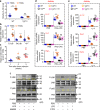Monoacylglycerol lipase regulates cannabinoid receptor 2-dependent macrophage activation and cancer progression
- PMID: 29968710
- PMCID: PMC6030061
- DOI: 10.1038/s41467-018-04999-8
Monoacylglycerol lipase regulates cannabinoid receptor 2-dependent macrophage activation and cancer progression
Abstract
Metabolic reprogramming greatly contributes to the regulation of macrophage activation. However, the mechanism of lipid accumulation and the corresponding function in tumor-associated macrophages (TAMs) remain unclear. With primary investigation in colon cancer and confirmation in other cancer models, here we determine that deficiency of monoacylglycerol lipase (MGLL) results in lipid overload in TAMs. Functionally, macrophage MGLL inhibits CB2 cannabinoid receptor-dependent tumor progression in inoculated and genetic cancer models. Mechanistically, MGLL deficiency promotes CB2/TLR4-dependent macrophage activation, which further suppresses the function of tumor-associated CD8+ T cells. Treatment with CB2 antagonists delays tumor progression in inoculated and genetic cancer models. Finally, we verify that expression of macrophage MGLL is decreased in cancer tissues and positively correlated with the survival of cancer patients. Taken together, our findings identify MGLL as a switch for CB2/TLR4-dependent macrophage activation and provide potential targets for cancer therapy.
Conflict of interest statement
The authors declare no competing interests.
Figures








Similar articles
-
Monoacylglycerol lipase blockades the senescence-associated secretory phenotype by interfering with NF-κB activation and promotes docetaxel efficacy in prostate cancer.Oncogene. 2024 Sep;43(38):2835-2849. doi: 10.1038/s41388-024-03132-y. Epub 2024 Aug 18. Oncogene. 2024. PMID: 39155296
-
Monoacylglycerol lipase regulates macrophage polarization and cancer progression in uveal melanoma and pan-cancer.Front Immunol. 2023 Mar 23;14:1161960. doi: 10.3389/fimmu.2023.1161960. eCollection 2023. Front Immunol. 2023. PMID: 37033945 Free PMC article.
-
The Cannabinoid Receptor 2 Protects Against Alcoholic Liver Disease Via a Macrophage Autophagy-Dependent Pathway.Sci Rep. 2016 Jun 27;6:28806. doi: 10.1038/srep28806. Sci Rep. 2016. PMID: 27346657 Free PMC article.
-
Research progress on FASN and MGLL in the regulation of abnormal lipid metabolism and the relationship between tumor invasion and metastasis.Front Med. 2021 Oct;15(5):649-656. doi: 10.1007/s11684-021-0830-0. Epub 2021 May 11. Front Med. 2021. PMID: 33973101 Review.
-
Genetic Manipulation of the Endocannabinoid System.Handb Exp Pharmacol. 2015;231:129-83. doi: 10.1007/978-3-319-20825-1_5. Handb Exp Pharmacol. 2015. PMID: 26408160 Review.
Cited by
-
ITGA5 is a prognostic biomarker and correlated with immune infiltration in gastrointestinal tumors.BMC Cancer. 2021 Mar 12;21(1):269. doi: 10.1186/s12885-021-07996-1. BMC Cancer. 2021. PMID: 33711961 Free PMC article.
-
Polarity scaffolds signaling in epithelial cell permeability.Inflamm Res. 2021 May;70(5):525-538. doi: 10.1007/s00011-021-01454-1. Epub 2021 Mar 15. Inflamm Res. 2021. PMID: 33721031 Review.
-
Lipids and cancer: Emerging roles in pathogenesis, diagnosis and therapeutic intervention.Adv Drug Deliv Rev. 2020;159:245-293. doi: 10.1016/j.addr.2020.07.013. Epub 2020 Jul 23. Adv Drug Deliv Rev. 2020. PMID: 32711004 Free PMC article. Review.
-
The unique immune ecosystems in pediatric brain tumors: integrating single-cell and bulk RNA-sequencing.Front Immunol. 2023 Nov 29;14:1238684. doi: 10.3389/fimmu.2023.1238684. eCollection 2023. Front Immunol. 2023. PMID: 38094301 Free PMC article.
-
Anti-inflammatory mechanisms in cancer research: Characterization of a distinct M2-like macrophage model derived from the THP-1 cell line.Cancer Med. 2023 Dec;12(23):21172-21187. doi: 10.1002/cam4.6681. Epub 2023 Nov 30. Cancer Med. 2023. PMID: 38037545 Free PMC article.
References
Publication types
MeSH terms
Substances
Grants and funding
LinkOut - more resources
Full Text Sources
Other Literature Sources
Molecular Biology Databases
Research Materials

